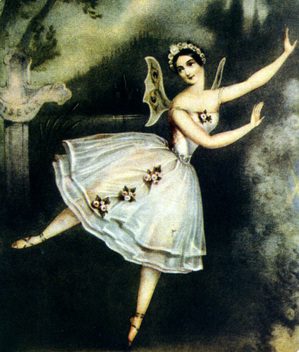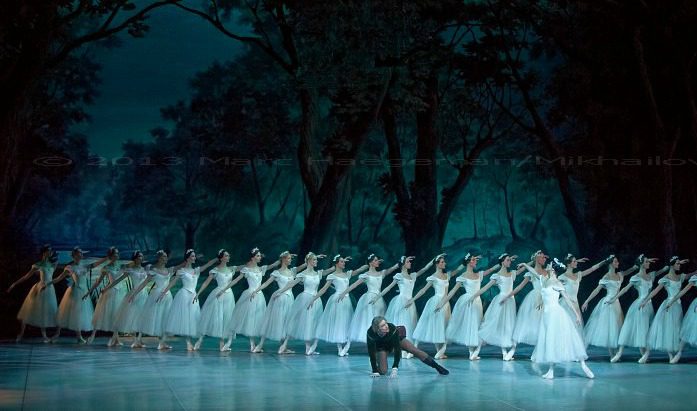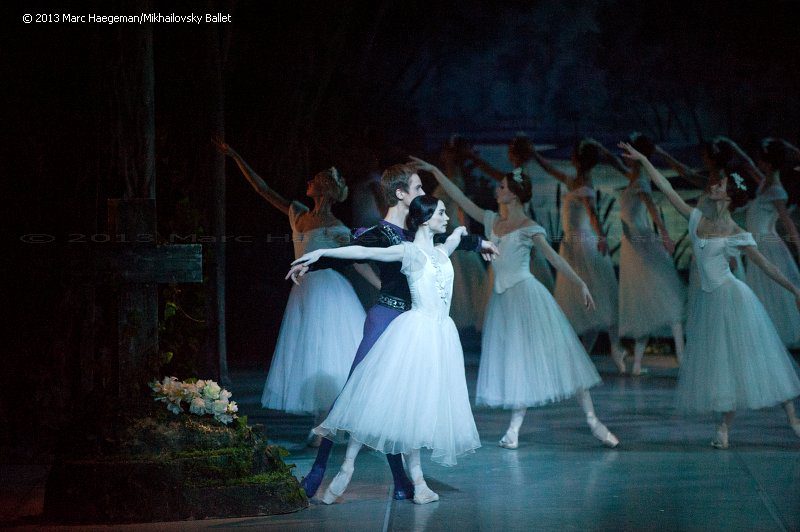Emily Boyle
Dublin, Ireland

The ballet Giselle may be one of the most sublime examples of the art form. Rightfully a classic, it forms a staple part of the repertoire and is performed on a regular basis worldwide. It is certainly a ballet of two halves, with the rustic, earthy, narrative-driven first half providing an absolute contrast to the ethereal, ballet-en-blanc atmosphere of Act Two. Giselle is a simple peasant girl with a love of dancing and a weak heart (we already sense trouble ahead), who has fallen in love with Albrecht, a recent arrival to her village, much to the displeasure of Hilarion whom she had previously favoured. A hunting party of noblemen arrive to take refreshment in the village, and one of their party, Bathilde, takes a shine to Giselle, who dances for her. Hilarion, who is suspicious of Albrecht, has broken into his cottage and found a sword and fine clothes, which he produces in front of everyone, proving that Albrecht is actually a duke who has been masquerading as a peasant. Indeed he is recognised by the hunting party, including Bathilde, and it soon transpires that Albrecht is in fact engaged to Bathilde. The shock of this discovery causes Giselle to lose her mind, and there is a famous mad scene culminating in her death at the end of Act One. Act Two is set at night in a forest clearing where we see Giselle’s newly made grave. Hilarion arrives to lay flowers; however, in keeping with local legends he is discovered by a group of Wilis, restless spirits of girls who were jilted before their wedding day and died of a broken heart. Every evening after nightfall they rise from their graves and dance in the forest led by their queen Myrtha. In an act of revenge, they force any young man they come across to dance until he is dead. Hilarion soon becomes a victim of this curse, forced to dance to the point of exhaustion. The Wilis throw him into the lake, and he drowns. Myrtha then summons the newly-buried Giselle from her grave, and she joins her new companions. Albrecht arrives to lay flowers at her grave and is discovered by the Wilis. Giselle begs Myrtha to spare him but is forced to entice Albrecht away from the protection of her headstone and dance with him. Albrecht is forced to keep dancing as Giselle tries to support him. Just as he collapses in the final stages of exhaustion, dawn breaks. The Wilis return to their graves, and Giselle must join them after bidding a final farewell to Albrecht.
The tragic plot of Giselle reads like a dark fairytale, but is there any medical basis for the events which occur?
Giselle’s own death takes place at the climax of a mad scene. This plot device is frequently seen in the arts; a similar scene takes place for example in Donizetti’s opera Lucia di Lammamoor at the end of which the heroine, Lucia, also dies. Although in some versions of the ballet, Giselle in the throes of her insanity actually stabs herself with Albrecht’s sword, in the first staging of the ballet in Paris in 1841 and in most subsequent versions, Giselle’s weak heart fails or is broken. Dramatic though it may sound, there is a medical basis for this. Stress cardiomyopathy is a recognised, non-ischaemic cardiomyopathy which is more poetically known as “broken-heart” syndrome.1 It has also been called Takotsubo cardiomyopathy and apical ballooning syndrome.2 Pathologically there is a sudden temporary weakening of cardiac muscle, which can be triggered by emotional stress. It is a well-recognised cause of acute heart failure, lethal ventricular arrhythmias, and ventricular rupture.

It is more common in women and can present with signs and symptoms similar to a myocardial infarction and is often mistaken for an acute coronary syndrome.3 There may be ECG changes but coronary angiogram is usually normal. Several pathophysiological mechanisms have been proposed to explain the features of this syndrome, such as multivessel coronary vasospasm, abnormalities in coronary microvascular function, and catecholamine-mediated cardiotoxicity.3 Stress cardiomyopathy was first described in the Japanese population in the 1990s; the disease entity was named Tako-Tsubo cardiomyopathy because of the way the left ventricle appeared on ventriculogram. The hypokinetic mid-ventricle and apex with a rounded bottom and narrow neck in systole resemble the traditional Japanese octopus trap for which it was named.4
Another plausible explanation for Giselle’s sudden death is the better known hypertropic obstructive cardiomyopathy (HOCM). This is recognised as a cause of sudden cardiac death in young people, especially those who play sports.5 It has been prominent in the media recently due to recent well known cases such as the collapse of soccer player Fabrice Muamba during a match in 2012 which occurred on live television. He was subsequently resucitated.6
Death as a result of physical exhaustion, such as death at the hands of the Wilis, has been famously described in Greek mythology in the well-known story of the first marathon runner, Pheidippides, who collapsed and died after running from Marathon to Athens to deliver news of a military victory against the Persians in the Battle of Marathon. According to Herodotus he was a trained runner but had to run in hot conditions. There are also different descriptions of the distance he ran, with some versions putting the distance at 140 miles. The idea of being forced to dance continuously has been explored previously, perhaps most famously in Hans Christian Andersen’s fairytale “The Red Shoes”7 and also in the ballet within the film of the same name. The dancer in these cases also met an unfortunate end!
Extreme and prolonged physical activity such as occurs in marathon running is associated with a low overall risk of death. Once the preserve of elite athletes, in recent years endurance events have become more popular, as has the number of amateur runners taking part in long distance running events.8 While moderate physical activity offers myriad number of health benefits, intense bursts of extreme physical activity can be associated with morbidity. There have been several reports of sudden death after long-distance running events.9 When sudden death occurs, it is usually cardiac-related and occurs in people with a prior history of cardiac disease. Matthews et al showed that 93% of cases of sudden death in marathon runners aged over forty-five was due to myocardial infarction.10

There are many physiological effects resulting from extreme physical activity such as hyperthermia, which can cause muscle weakness, confusion, and loss of consciousness in extreme cases;11 hyponatraemia, which may be severe enough to cause seizures and cerebral oedema;12 glycogen depletion; and actual physical injury. Hyperthermia and impaired temperature regulation have been implicated in the deaths of some young people who have collapsed at discos after ingesting even small amounts of MDMA.13 Water intoxication after dancing for hours in these cases has also been implicated.14 Therefore, some of these people can be said to have danced to their death.
There are other rare adverse events such as acute mesenteric ischemia which has been described in several case reports.15-17 The mechanism for this is exercise-induced stimulation of the sympathetic nervous system resulting in a blood flow shunt from the splanchnic system towards the muscles.16, 18 This is the primary cause of ischemic colitis in athletes. Similarly to cases seen in patients as a result of hypoperfusion, the splenic flexure and the rectosigmoid junction are the watershed areas in the colon that are more prone to ischemia. It takes a 75% reduction for up to twelve hours in the mesenteric blood flow to induce microscopic changes in the healthy colon. Exercising at 70% of maximal oxygen consumption causes a splanchnic blood flow reduction up to 60–70%.19,20 Dehydration and NSAID use in athletes may be confounding factors.17 Although it rarely requires surgical intervention, acute mesenteric ischemia in athletes may cause significant morbidity.
In Giselle, the unfortunate Hilarion is danced to the point of exhaustion by the Wilis and then thrown into the lake, so the actual mechanism of his death is drowning, although we can assume the physiological insult suffered prior to this impaired his chances of saving himself. Albrecht is also danced to the point of death, but given a last minute reprieve when dawn breaks. However there were probably countless young men before him who were less fortunate. The idea of the protection from evil forces offered by daylight is also a common theme in literature, explored perhaps most famously as a feature of limitation in Bram Stoker’s Dracula, and in many books and films since.
The plot of Giselle therefore may be tragic and dramatic but there are elements in it which are not wholly incredible. The powerful and moving music and choreography however create an effect that is difficult to convey in everyday language and is best experienced firsthand.
References
- http://www.heart.org/HEARTORG/Conditions/More/Cardiomyopathy/Is-Broken-Heart-Syndrome-Real_UCM_448547_Article.jsp
- Gianni M, Dentali F, et al. “Apical ballooning syndrome or takotsubo cardiomyopathy: a systematic review”. European Heart Journal 2006;27 (13): 1523–1529.
- Prasad A, Lerman A, Rihal CS. Apical ballooning syndrome (Tako-Tsubo or stress cardiomyopathy): a mimic of acute myocardial infarction. Am Heart J. 2008;155:408–417
- Dote K, Sato H, Tateishi H, Uchida T, Ishihara MMyocardial stunning due to simultaneous multivessel coronary spasms: a review of 5 cases. J Cardiol 1991;21:203-214
- Higgins JP, Andino A. Soccer and Sudden Cardiac Death in Young Competitive Athletes: A Review. J Sports Med 2013; http://dx.doi.org/10.1155/2013/967183
- http://www.theguardian.com/football/2012/mar/18/heart-disorder-hocum-fabrice-muamba
- Andersen, Hans Christian. The Red Shoes. In Tales. Odense (Denmark): Flensted, 1972
- Kim JH et al.Cardiac arrest during long-distance running races N Engl J Med 2012; 366:130-140
- Lamppa R. 2010 Marathon, half marathon and state of the sport reports. Running USA, 2010 (http://www.runningusa.org/statistics/reports).
- Mathews SC Mortality among marathon runners in the United States, 2000-2009. Am J Sports Med. 2012 Jul;40(7):1495-500
- American College of Sports Medicine. 1996. Heat and cold illnesses during distance running. Medicine and Science in Sports and Exercise 28(12):i-x.
- Davis, D.P., J.S. Videen, A. Mario, G.M. Vilke, J.V. Dunford, S.P. Van Camp, and L.G. Mararam. 2001. Exercise-associated hyponatremia in marathon runners: A two-year experience. J Emerg Med 21(1):47-57
- https://www.drugabuse.gov/publications/drugfacts/mdma-ecstasymolly
- “1995: Ecstasy pill puts party girl in coma”. BBC News. 13 November 1995
- Heer M, Repond F, Hany A, Sulser H, Kehl O, Jager K. Acute ischaemic colitis in a female long distancerunner. Gut 1987;28:896-899
- Cohen DC, Winstanley A, Engledow A, Windsor AC, Skipworth JR. Marathon-induced ischemic colitis: why running is not always good for you. Am J Emerg Med. 2009 Feb;27(2):255.e5-7
- Grames C, Berry-Cabán CS. Case Report Ischemic Colitis in an Endurance Runner Case Reports in Gastrointestinal Medicine 2012. Volume 2012 Article ID 356895, http://dx.doi.org/10.1155/2012/356895
- Sanchez LD, Tracy JA, Berkoff D, Pedrosa I. Ischemic colitis in marathon runners: a case-based review J Emerg Med 2006;30(3): 321–326
- De Oliveira EP, Burini RC. The impact of physical exercise on the gastrointestinal tract. Curr Opin Clin Nutrition Metabolic Care 2009; 12(5): 533–538
- Ho GWK. Lower gastrointestinal distress in endurance athletes. Curr Sports MediReports 2009;8(9):85–91
EMILY BOYLE received her medical degree in 2004 from the Royal College of Surgeons in Ireland. Having worked in several hospitals around Ireland she currently is a vascular trainee working in Dublin. She has always had an interest in ballet and music and lists Giselle among her favourites.

Leave a Reply